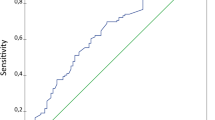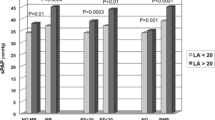Abstract
Background
A v wave on pulmonary artery wedge (PAW) pressure sometimes augments and appears on pulmonary artery (PA) pressure wave in patients with heart failure (HF). However, the significance of PA v wave in HF remains to be elucidated.
Methods
We retrospectively analyzed pressure waveforms in 61 HF patients (left ventricular ejection fraction 35 ± 15%). On the PAW and PA pressure waveforms, mean pressure as well as peak and amplitude of v waves (ampPAWv and ampPAv, respectively) were measured. Occurrence of worsening HF and cardiac death was recorded for 2 years after the catheterization.
Results
The ampPAWv did not correlate with ampPAv. When the patients were divided into 4 groups: I (high-ampPAWv/high-ampPAv), II (high-ampPAWv/low-ampPAv), III (low-ampPAWv/high-ampPAv), and IV (low-ampPAWv/low-ampPAv), the prevalence of group III was low (I: 13, II: 17, III: 4, IV: 27). Mean pressures of PAW and PA were similarly elevated in groups I and II. Cardiac index was lowest (I: 2.0 ± 0.4, II: 2.8 ± 0.6, III: 2.2 ± 0.2, IV: 2.4 ± 0.6 L/min/m2, ANOVA P < 0.01, P < 0.01 for I vs II) and tricuspid annular plane systolic excursion / systolic PA pressure was impaired (I: 0.27 ± 0.07, II: 0.48 ± 0.22, III: 0.59 ± 0.35, IV: 0.68 ± 0.35 mm/mmHg, ANOVA P < 0.01) in group I. During the follow-up, 13 events were observed. Kaplan–Meier analysis showed that patients in group I were at highest risk of cardiac events.
Conclusions
PA v was observed mainly in patients with augmented PAW v wave and decreased cardiac index, suggesting an advanced stage of HF. Moreover, augmented PAv was associated with worse outcome in HF patients.





Similar content being viewed by others
References
Swan HJ, Ganz W, Forrester J, Marcus H, Diamond G, Chonette D (1970) Catheterization of the heart in man with use of a flow-directed balloon-tipped catheter. N Engl J Med 283:447–451
Cooper LB, Mentz RJ, Stevens SR, Felker GM, Lombardi C, Metra M, Stevenson LW, O'Connor CM, Milano CA, Patel CB, Rogers JG (2016) Hemodynamic predictors of heart failure morbidity and mortality: fluid or flow? J Card Fail 22:182–189
Nagueh SF, Smiseth OA, Appleton CP, Byrd BF 3rd, Dokainish H, Edvardsen T, Flachskampf FA, Gillebert TC, Klein AL, Lancellotti P, Marino P, Oh JK, Popescu BA, Waggoner AD (2016) Recommendations for the evaluation of left ventricular diastolic function by echocardiography: an update from the American Society of Echocardiography and the European Association of Cardiovascular Imaging. J Am Soc Echocardiogr 29:277–314
Mehta S, Charbonneau F, Fitchett DH, Marpole DG, Patton R, Sniderman AD (1991) The clinical consequences of a stiff left atrium. Am Heart J 122:1184–1191
Roy S, Couture P, Qizilbash B, Toupin F, Levesque S, Carrier M, Lambert J, Denault AY (2013) Hemodynamic pressure waveform analysis in predicting fluid responsiveness. J Cardiothorac Vasc Anesth 27:676–680
Pichard AD, Diaz R, Marchant E, Casanegra P (1983) Large V waves in the pulmonary capillary wedge pressure tracing without mitral regurgitation: the influence of the pressure/volume relationship on the V wave size. Clin Cardiol 6:534–541
Ha JW, Chung N, Jang Y, Kang WC, Kang SM, Rim SJ, Shim WH, Cho SY, Kim SS (2000) Is the left atrial v. wave the determinant of peak pulmonary artery pressure in patients with pure mitral stenosis? Am J Cardiol 85:986–991
Snyder RW 2nd, Glamann DB, Lange RA, Willard JE, Landau C, Negus BH, Hillis LD (1994) Predictive value of prominent pulmonary arterial wedge V waves in assessing the presence and severity of mitral regurgitation. Am J Cardiol 73:568–570
Hayashi H, Abe Y, Morita Y, Nakane E, Haruna Y, Haruna T, Inoko M (2018) The accuracy of a large V wave in the pulmonary capillary wedge pressure waveform for diagnosing current mitral regurgitation. Cardiology 141:46–51
Carley JE, Wong BY, Pugh DM, Dunn M (1977) Clinical significance of the V wave in the main pulmonary artery. Am J Cardiol 39:982–985
Grose R, Strain J, Cohen MV (1984) Pulmonary arterial V waves in mitral regurgitation: clinical and experimental observations. Circulation 69:214–222
de Man K, de Ruiter GS, van der Wouw PA (2006) A clearly visible V wave in the pulmonary artery pressure curve caused by severe mitral valve regurgitation. Neth Heart J 14:312–313
Lang RM, Badano LP, Mor-Avi V, Afilalo J, Armstrong A, Ernande L, Flachskampf FA, Foster E, Goldstein SA, Kuznetsova T, Lancellotti P, Muraru D, Picard MH, Rietzschel ER, Rudski L, Spencer KT, Tsang W, Voigt JU (2015) Recommendations for cardiac chamber quantification by echocardiography in adults: an update from the American Society of Echocardiography and the European Association of Cardiovascular Imaging. J Am Soc Echocardiogr 28(1–39):e14
Nishimura RA, Otto CM, Bonow RO, Carabello BA, Erwin JP 3rd, Guyton RA, O'Gara PT, Ruiz CE, Skubas NJ, Sorajja P, Sundt TM 3rd, Thomas JD (2014) 2014 AHA/ACC guideline for the management of patients with valvular heart disease: a report of the American College of Cardiology/American Heart Association Task Force on Practice Guidelines. J Am Coll Cardiol 63:e57–185
Grandin EW, Zamani P, Mazurek JA, Troutman GS, Birati EY, Vorovich E, Chirinos JA, Tedford RJ, Margulies KB, Atluri P, Rame JE (2017) Right ventricular response to pulsatile load is associated with early right heart failure and mortality after left ventricular assist device. J Heart Lung Transplant 36:97–105
Rich S, Levy PS (1984) Characteristics of surviving and nonsurviving patients with primary pulmonary hypertension. Am J Med 76:573–578
Guazzi M, Borlaug BA (2012) Pulmonary hypertension due to left heart disease. Circulation 126:975–990
Nohria A, Tsang SW, Fang JC, Lewis EF, Jarcho JA, Mudge GH, Stevenson LW (2003) Clinical assessment identifies hemodynamic profiles that predict outcomes in patients admitted with heart failure. J Am Coll Cardiol 41:1797–1804
de Groote P, Millaire A, Foucher-Hossein C, Nugue O, Marchandise X, Ducloux G, Lablanche JM (1998) Right ventricular ejection fraction is an independent predictor of survival in patients with moderate heart failure. J Am Coll Cardiol 32:948–954
Binanay C, Califf RM, Hasselblad V, O'Connor CM, Shah MR, Sopko G, Stevenson LW, Francis GS, Leier CV, Miller LW, Investigators E, Coordinators ES (2005) Evaluation study of congestive heart failure and pulmonary artery catheterization effectiveness: the ESCAPE trial. JAMA 294:1625–1633
Cotter G, Cotter OM, Kaluski E (2008) Hemodynamic monitoring in acute heart failure. Crit Care Med 36:S40–43
Doshi R, Patel H, Shah P (2018) Pulmonary artery catheterization use and mortality in hospitalizations with HFrEF and HFpEF: a nationally representative trend analysis from 2005 to 2014. Int J Cardiol 269:289–291
Gerges C, Gerges M, Lang MB, Zhang Y, Jakowitsch J, Probst P, Maurer G, Lang IM (2013) Diastolic pulmonary vascular pressure gradient: a predictor of prognosis in "out-of-proportion" pulmonary hypertension. Chest 143:758–766
Omote K, Nagai T, Asakawa N, Kamiya K, Tokuda Y, Aikawa T, Fukushima A, Noguchi K, Kato Y, Komoriyama H, Nishida M, Kudo Y, Iwano H, Yokota T, Anzai T (2019) Impact of admission liver stiffness on long-term clinical outcomes in patients with acute decompensated heart failure. Heart Vessels 34:984–991
Funding
None.
Author information
Authors and Affiliations
Corresponding author
Ethics declarations
Conflict of interest
The authors have no conflict of interest to be disclosed.
Additional information
Publisher's Note
Springer Nature remains neutral with regard to jurisdictional claims in published maps and institutional affiliations.
Electronic supplementary material
Below is the link to the electronic supplementary material.

380_2020_1580_MOESM1_ESM.jpg
Supplemental Figure Kaplan-Meier curve analysis of event free survival of patients with significant PA v wave and those without. Abbreviations are the same as Figure 5. (JPG 59 kb)
Rights and permissions
About this article
Cite this article
Iwano, H., Yokoyama, S., Kamiya, K. et al. Significance and prognostic impact of v wave on pulmonary artery pressure in patients with heart failure: beyond the wedge pressure. Heart Vessels 35, 1079–1086 (2020). https://doi.org/10.1007/s00380-020-01580-6
Received:
Accepted:
Published:
Issue Date:
DOI: https://doi.org/10.1007/s00380-020-01580-6




